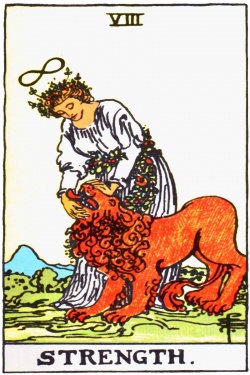Strength: Difference between revisions
An Avatar.Global Resource
Text replacement - "]]" to " [[" |
|||
| Line 47: | Line 47: | ||
{{endstuff}} | {{endstuff}} | ||
[[category:terms]][[Is an::Old Energy Archetype| ]][Is related to::Fool in School| ]][[Is related to::Good versus Evil| ]] | [[category:terms]] | ||
[[Is an::Old Energy Archetype| ]][Is related to::Fool in School| ]] | |||
[[Is related to::Good versus Evil| ]] | |||
{{#seo: | {{#seo: | ||
Latest revision as of 09:26, 19 December 2022
Strength
Strength is an Old Energy Archetype from the Masonic Tarot Deck. In the Book of Slavery and Book of Power, the archetype is used to equate strength with domination, illustrated visually by the women's domination of a lion, representing nature.

List of Old Energy Archetypes from the Masonic Tarot
Chariot, Death (archetype), Duality, Hermit, Hierophant, High Priestess, Judgement, Justice, Star, Strength, Sun (archetype), Temperance, The Devil, The Emperor, The Empress, The Fool, The Hanged Man, The Lovers, The Magician, The Moon, The Tower, The Wheel of Fortune, The World (old energy)
Related Terms
Old Energy Archetypes > Book of Slavery
Notes
Book of Power
In the Book of Power, this refers to the prefered mode of control. Remembering that the Masonic Tarot marks the transition from Feudalism to Capitalism, this card admonishes the masters to adopt a new form of control, one where rule is not achieved with autocratic violence, but one where rule is achieved via alternative means.
"Power, energy, action, courage, magnanimity; also complete success and honours. Reversed: Despotism, abuse of power, weakness, discord, sometimes even disgrace."[1]
As one commentator puts it "Be it through compassion, cunning, or understanding, Strength signifies true control of a situation, and not simply the power to forcefully impose your will."[2]
In addition to stipulating how control of others is to be achieved, this archetype also admonishes us to control our selves. Here we find elements of the Fool in School constellation, the notion that trials, testing, and tribulation built strength.
(the Strength; the brother who has become strong through mastering his own person.) Trial by Fire exteriorizes inner heat.[3]
Here, the fool is on a journey to "tame the dark side," a typical Zoroastrian theme.[4]
In psychological terms, this "dark side" is the unconsciousness, often shadow, which must be tamed and suppressed. As Pollack notes, "Now consider Strength.... The picture shows a woman taming a lion. Briefly, the image suggests the energy of the unconscious released and calmed, 'tamed' by the direction of conscious understanding."[5] "passions conquered by reason." (p. 76).
Assumption that humans have a "dark side" which must be controlled by higher reason "This also represents the mastery of the lower by the higher. But in this case it is the soul which holds in check the passions, although her feet are still planted on earth, and the dark veil still floats about her head and clings around her."[6]
Subduing the self: "(Strength) maintains the balance between desire and will." [7]
Book of Slavery
Recovery
"By making Strength number 8 we set it against the Chariot, as a different kind of power, not the ego's will, but the inner Strength to confront yourself calmly and without fear. The mysteries can be brought out because we have found the Strength to face them. The lion signifies all the feelings, fears, desires, and confusions sup pressed by the ego in its attempt to control life. The charioteer drew upon his inner feelings as a source of energy, but was always careful to direct that energy where he consciously decided it should go. Strength allows the inner passions to emerge, as the first step in going beyond the ego....On a deeper level the lion symbolizes the whole force of personality, usually smoothed over by the demands of civilized life...This purpose can only be accomplished because the lion is 'tamed' at the same time that it is released.. [8]
Just note the intellectual contortions Pollack is going through to make this a sensible and progressive archetype.
Citation and Legal
Treat the SpiritWiki as an open-access online monograph or structured textbook. You may freely use information in the SpiritWiki; however, attribution, citation, and/or direct linking are ethically required.
Footnotes
- ↑ ———. The Pictorial Key to the Tarot: Being Fragments of a Secret Tradition Under the Veil of Divination. London: Rider, 1911. p. 284.
- ↑ Edelwyn Collective. “The Strength Tarot Card’s True Meaning: Love, Health and Money.” Edelwyn (blog), 2020. https://www.edelwyn.com/strength/.
- ↑ Wirth, Oswald. Tarot of the Magicians: The Occult Symbols of the Major Arcana That Inspired Modern Tarot. San Francisco. CA: Weiser Books, 1990. p. 171.
- ↑ Sosteric, Mike. “From Zoroaster to Star Wars, Jesus to Marx: The Art, Science, and Technology of Human Manipulation,” Unpublished. https://www.academia.edu/34504691.
- ↑ Pollack, Rachel. Seventy-Eight Degrees of Wisdom. Harper Collins, 1980.
- ↑ Wang, Robert. An Introduction to the Golden Dawn Tarot. Main: Sam Weiser, 1978. p. 138.
- ↑ Case, Paul Foster. An Introduction to the Study of the Tarot. New York: Kindle Edition, 1920. p.30.
- ↑ Pollack, Rachel. Seventy-Eight Degrees of Wisdom. Harper Collins, 1980 p. 74.
[Is related to::Fool in School| ]]
{{#seo:
|author="Mike Sosteric"
|title=Tarot Card Meanings Old Energy
|title_mode=append
|keywords=tarot, freemasons, freemasonry
|site_name=The SpiritWiki
|description=The Old Energy Masonic Meanings of the The Strength Tarot Card
}}
